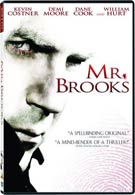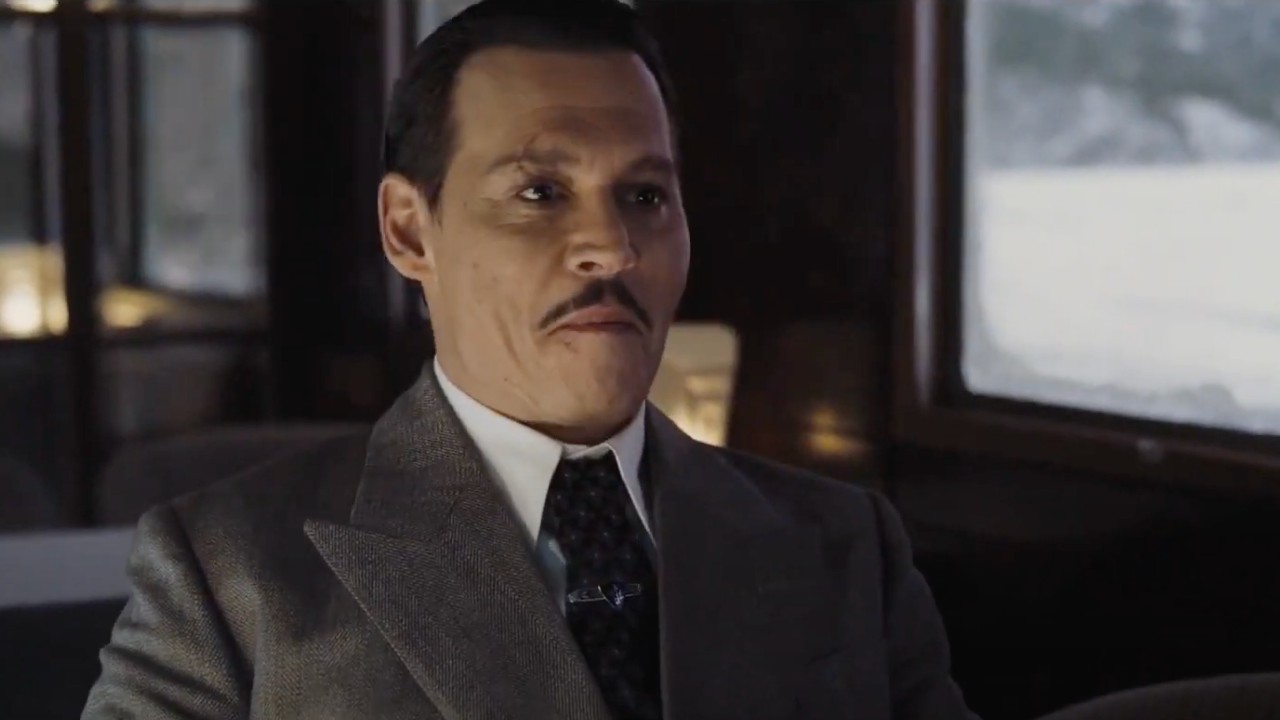A serial killer is a person who murders three or more people in three or more separate events over a period of time. These people usually appear to be quite normal, seemingly wearing a mask to cover their insanity. Other times, they’re out there and looking to get caught – hoping a good detective will join him or her in a little game where, if you fall one move behind, someone else loses their life. Kevin Costner stars as Mr. Brooks, a mild-mannered man who appears to have everything in life – a successful business, the perfect house, a beautiful wife (Marg Helgenberger), and a college-bound daughter (Danielle Panabaker). It’s hard to believe that this man with the perfect image and a Man of the Year award from the Chamber of Commerce is also a cold-hearted killer known as the Thumb Print Killer – a title given to him by the cops because he dips his victims’ fingers in their own blood and leaves a fingerprint somewhere at the crime scene. Only a sick and twisted man is capable of doing something like this. That is where Marshall (William Hurt) comes in.
At first, Marshall seems like Mr. Brooks’ boss, hiring him to do the killing. Then, as their interaction grows, you see that Marshall is really Mr. Brooks’ inner voice – a voice he has subdued for years by going to Alcoholics Anonymous meetings in hopes of ridding himself of his addiction to kill. “The hunger has returned to Mr. Brooks’ brain. It never really left.”
On his first night back to killing, however, there is one unexpected glitch in the plan: after leaving the blinds open to the bedroom window while executing two people having sex, an amateur photographer/voyeur, Mr. Smith (Dane Cook), catches a glimpse of Brooks. Even worse for Brooks, this photographer takes photos of everything that takes place and could turn in the famous Thumbprint Killer to Detective Tracy Atwood (Demi Moore), who specializes in tracking down serial killers. Mr. Smith, however, doesn’t want to turn in the notorious killer because he wants something from him – he wants to watch Mr. Brooks kill.
Costner plays this methodical, super-intelligent killer with ease. He’s smart, witty and always two steps ahead of his prey and the police. He may seem a little dull when he is performing his every day tasks as a the owner of a box making company and father, but when he and Marshall decide it’s time to have a little fun, there is plenty of fun to be had watching him fulfill his need to kill, mainly because of the interaction between Costner and Hurt. Some of their actions are tediously boring but, more often than not, these two laugh together as they are forming a plan and talking about the kill. They begin to have fun and it shows Mr. Brooks’ chilling dual personality. Costner and Hurt are the perfect on-screen pairing.
Costner also does an outstanding job portraying a killer that has stresses compounding – his daughter might be too much like him, a photographer is blackmailing him, he has to maintain the perfect image, and he still has those pesky police chasing him. Most of all, he wants to lead a normal life, and you can tell this could happen if he could rid himself of his addiction, because he is too smart to ever be caught. In a way, his life is sorted into the boxes he makes – some of them are open to everyone to see, while others are sealed tightly.
Cook’s big-screen resume shows a knack for annoying comedy and mediocre acting in painstakingly bad comedies. However, he makes a surprising transition into this dark role of Mr. Smith. While he is not incredible, he is enough of a distraction to allow Costner and Hurt to pull of their master plan. Cook does show he can be serviceable and tolerable in small doses and a supporting part.
The major problem with Mr. Brooks is there are too many storylines – some of them intersecting with others, while others stand aimlessly on their own, not allowing enough time for many of them to be developed. The focus is clearly everything going on with Mr. Brooks, which is also part of the problem – there’s so much going on with Mr. Brooks. His daughter is pregnant, dropping out of college, and there is a chance she killed the father of her child. On top of that, Brooks is being blackmailed by this creepy voyeur, who suddenly has Atwood, a gorgeous and wealthy detective, watching him. If that wasn’t enough, Atwood is dealing with several storylines of her own: an escaped serial killer is looking for her, she is in the midst of a high-priced divorce and, after all these years, she can’t find the Thumbprint Killer. There’s a lot going on, and there’s just not enough time to develop all of these stories, especially when they should be focusing solely on Mr. Brooks – there is a reason the movie is named Mr. Brooks and not “Mrs. Atwood,” or “Brooks & Friends.”
Your Daily Blend of Entertainment News
Mr. Brooks is a well-made and well-acted psychological thriller that won’t keep you at the edge of your seat the whole time, but will keep you, and the voices inside your head, highly entertained. It will satisfy your craving for a serial killer movie, and it will keep your mind active trying to follow all of the stories, but it will ruin your appetite when Costner decides it’s necessary to bare his ass – unless, of course, that is your addiction. If the voices inside your head are still begging for more, and you don’t feel it’s necessary to call a psychologist and seek help, there is plenty more available to satisfy your hunger. The DVD for Mr. Brooks is not loaded with special features, but has more than enough to keep you interested, just like the movie.
If you like a film, some of the best features are the commentaries. They allow you to watch the film again and begin to understand the reasons for certain scenes and uses of certain camera angles. For Mr. Brooks, the commentary is kind of boring as screenwriter Raynold Gideon and Evans do all the talking. It’s boring, not because the film is bad, but because these guys ramble on – it’s like they’ve never done commentary for a DVD before. For example, in the first six minutes of the commentary, instead of talking about what’s going on in the movie, they talk about contract discussions to land Costner and Hurt. It’s not that it’s not interesting to hear, but they spend so much time talking about how negotiations went back and forth, and back and forth. It’s tediously boring.
Another DVD staple are the deleted scenes, and Mr. Brooks has six of them, including scenes titled “Atwood’s Date,” “Broken Cell Phone,” and “Marshall’s Origin,” which is actually a very interesting clip. Another interesting scene is the alternate opening. Instead of a black screen with just the voice of Costner praying and Hurt speaking over him, trying to lure him out for a kill, there are still, black and white pictures of nude victims of the Thumbprint Killer. It’s different, and will make you compare the two beginnings, but I think they made the right choice – this movie is not intended to shock, it’s intended to make you think.
“The Birth of a Serial Killer: The Writing of Mr. Brooks” is a seven-minute feature where Evans, Gideon and producer Jim Wilson talk about the creation of Mr. Brooks. An interesting comment in this trailer is Gideon describing the script as being “moral,” because it’s a man fighting an addiction because he loves his family and he wants to protect them. It is shocking because the words moral and murder have nothing in common besides a few letters. In a way he has a good point, but in many other ways, he’s nuts. It’s a good feature, though, especially if you like to hear how a character is created.
“Murder on Their Minds: Mr. Brooks, Marshall, and Mr. Smith,” is similar to the typical making-of feature, but it focuses on three characters and their evolution in the film, and now how great the director is, or why it was so much fun to come to the set each and every day. It is a series of interviews with Evans, Costner and Cook about the characters and what makes them tick. It is a 25-minute feature that is definitely worth watching. The remaining features are four trailers - one is the theatrical release trailer for Mr. Brooks, while the others are for an upcoming movie called Day Watch, and the 20th Anniversary Edition of Wall Street.
The special features are much like the character of Mr. Brooks. Some of the material may be boring, but it is a series of well-planned events. There is nothing about the packaging that is flashy. The menus are simple, just pictures of the characters in the film and creepy music playing over and over again. There may be a few flaws, but it’s nothing Mr. Brooks can’t cover up.

